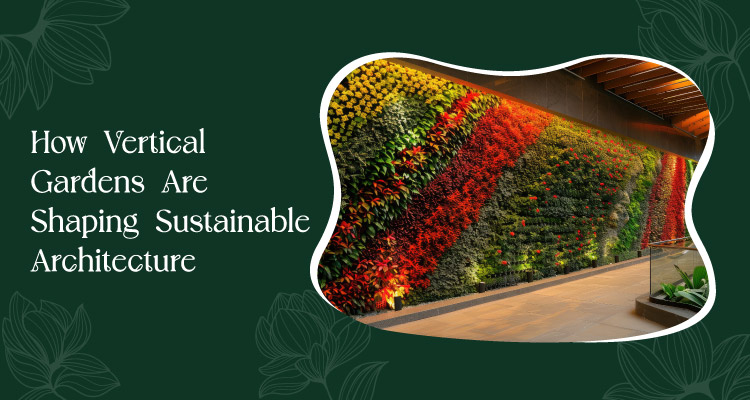Cities are growing taller and denser. But your buildings still need to work for people, not just on paper, but in real life. That’s why vertical gardens are becoming a serious part of sustainable architecture. They’re not decorative features. They’re working systems that support air purification, temperature control, biodiversity, and well-being. You’re using walls that already exist to deliver more function without taking up extra space.
If you’re designing for long-term performance, sustainable vertical gardens are no longer optional. They’re practical, flexible, and aligned with what both cities and people need.
A] What Are Vertical Gardens in Architecture?
A vertical garden is a planted wall. It can be part of a new construction or added to an existing building. It’s designed to hold and grow plants vertically using a structural backing, soil medium, and irrigation system. Some are fully automated, while others are designed for hands-on care. Either way, they support plant growth without relying on the ground.
You can install them on interior or exterior surfaces. Entryways, corridors, facades, and atriums—any space where vertical area outweighs floor area becomes usable for plant life. That gives you more design control without increasing your building’s footprint.
The systems vary, but the purpose stays the same. You’re making your building do more—cooling itself, cleaning the air, supporting biodiversity, and managing water. That shifts your project toward vertical gardens & sustainable design, making a real environmental contribution.
Curious how vertical gardens are redefining modern architecture?
B] Environmental Benefits of Vertical Gardens
Thermal Control
Sunlight hits building exteriors all day. That drives up heat levels and forces cooling systems to work harder. Vertical gardens intercept that heat. They act as insulation, blocking and absorbing solar radiation. That reduces the surface temperature of your exterior walls and helps lower internal temperature swings. You get more consistent indoor comfort and reduced energy demand.
Cleaner Air
Plants are natural air filters. Through a process called phytoremediation, they absorb certain toxins and convert carbon dioxide into oxygen. When you place plants across a wall, you multiply that effect. Vertical garden architecture helps remove pollutants like nitrogen dioxide and particulate matter, which are common in cities. That improves air quality both inside and near the building.
Carbon Absorption
Every plant in your vertical system takes in carbon dioxide during photosynthesis. Multiply that by hundreds of plants, and you’re making a direct contribution to carbon reduction. While the effect isn’t a total offset, it moves your design in the right direction. That counts toward building performance metrics and supports broader sustainability goals.
Rain Management
Vertical gardens absorb water. When it rains, your system acts like a sponge. It slows the movement of water, reducing surface runoff. That gives storm drains more time to handle volume. In some setups, the gardens store water for reuse. That supports better water management and reduces demand on public systems during heavy rainfall.
Noise Control
Sound bounces off hard surfaces. A planted wall absorbs it. Plants, growing medium, and supporting layers all contribute to sound dampening. That helps reduce traffic noise, construction clatter, or mechanical noise near your building. Inside, vertical gardens can create quieter zones that feel more focused and less stressful.
C] Vertical Gardens as a Biodiversity Hub
Most urban projects remove green space. That limits food sources, shelter, and pathways for birds, insects, and other wildlife. Vertical gardens return some of that function without needing extra land.
Pollinator Access
Pollinators are key to healthy ecosystems. Green walls filled with flowering plants can attract bees, butterflies, and other beneficial insects. That helps keep nearby plant systems healthy and supports food supply cycles even in tight city spaces.
Shelter and Habitat
Plants on vertical walls create shelter. Small birds and insects can use them to hide, nest, or feed. In larger installations, a professional vertical garden service in India can add boxes or materials designed to support specific species. That strengthens your project’s environmental footprint without increasing risk or maintenance load.
Plant Variety
Urban planting is often limited by soil conditions, space, or maintenance demands. Vertical gardens change that. You can grow native species or drought-tolerant plants that might not do well at ground level. You’re supporting plant diversity and contributing to climate adaptation by choosing species that make sense for your project location.
Microclimate Support
Every building affects local temperature, wind, and moisture. A vertical garden helps smooth those effects. It adds shade, increases humidity, and reduces surface heat. That improves comfort for people walking near the building and supports other green features like roof gardens or permeable paving.
D] Aesthetic and Psychological Impact
Green space changes how people feel in buildings. It lowers stress. It supports better mental focus. It improves sleep and recovery rates. These aren’t small effects. They’re backed by years of research.
Better Focus
Visual contact with greenery improves cognitive performance. That makes vertical gardens a strong addition to offices, classrooms, and shared spaces. You’re helping people stay sharp and engaged without changing the structure of the room.
Visual Clarity
Green walls soften the look of materials like metal, glass, or concrete. They add pattern and movement. They give users something visual to pause on, which can reduce fatigue from long days indoors or high exposure to screens and artificial light.
Stress Relief
Natural elements help lower cortisol levels. They reduce anxiety and support better mood regulation. Even short exposure to greenery, through walking past or sitting near a green wall, can improve mental well-being. That’s valuable in high-pressure settings like hospitals, offices, or transport hubs.
Brand Strength
People associate green design with responsibility. When your project includes a visible, functioning vertical garden, it signals long-term thinking. That builds trust with clients, tenants, and investors. It reflects clearly on your attention to quality and sustainability.
Connect With Us Today
For expert advice and personalized solutions for your green space needs.
Call: +91-84339 29564 | Email: info@lucentcorporation.com
E] Integration into Sustainable Building Systems
Vertical gardens aren’t isolated features. They work best when planned as part of your broader building systems and with the help of a leading landscaping company in India.
Certifications
Green walls support points in LEED, WELL, and other certifications. That includes categories related to air quality, heat island reduction, indoor environmental quality, and water use. You’re not just checking boxes. You’re adding systems that deliver clear benefits.
Water Use
Good irrigation systems reduce waste. Vertical gardens often use drip lines, timers, or moisture sensors to control how much water plants receive. Some also collect and reuse rainwater. That means your system works efficiently without driving up water demand. Providers offering garden maintenance in India ensure that such systems stay functional, healthy, and cost-effective over the long term.
Pairing with Solar
Solar panels perform better at cooler temperatures. Vertical gardens help lower wall and roof surface temperatures, creating a better environment for solar panels. You support both clean energy production and passive cooling in the same design.
Modular Panels
Prefabricated green wall panels allow for quicker installation. You can scale the system up or down based on site constraints or project phase. That makes it easier to keep timelines on track and manage the budget without cutting quality.
Working with Lucent Gardens
Vertical gardens deliver strong results, but only if they’re designed with purpose. That includes plant selection, structural design, irrigation, and maintenance planning.
Lucent Gardens provides vertical garden systems that are built to match your site, building type, and climate. Their approach is direct. You get systems that are practical, maintainable, and aligned with your goals.
They work with architects and developers from concept to completion. That includes design input, installation support, and long-term performance planning. You control your project while using their expertise to get it right.
A vertical garden is a proven tool if your building needs to meet higher environmental targets or improve user experience. Contact us to help you make the most of it.

Mr. Dilip Murkute
As the founder of Lucent Gardens, Mr. Dilip Murkute draws from his years of experience in hospitality and entrepreneurship. His vision is to create functional, aesthetically pleasing green spaces. Under his leadership, Lucent Gardens delivers sustainable, high-quality landscaping solutions with a commitment to excellence and innovation.




